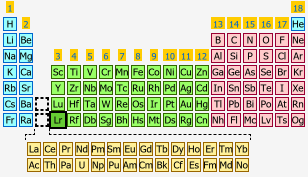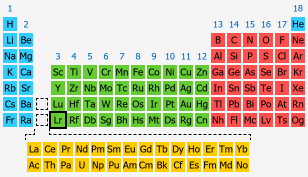References (Click the
 next to a value above to see complete citation information for that entry)
next to a value above to see complete citation information for that entry)
Connelly, Neil G., Ture Damhus, Richard M. Hartshorn, and Alan T. Hutton. Nomenclature of Inorganic Chemistry: IUPAC Recommendations 2005. Cambridge: RSC Publishing, 2005.
Cambridge: RSC Publishing, 2005.
Cox, P. A. The Elements: Their Origin, Abundance and Distribution. Oxford: Oxford University Press, 1989.
de Podesta, Michael. Understanding the Properties of Matter, 2nd edition. London: Taylor & Francis, 2002.
Emsley, John. Nature's Building Blocks: An A-Z Guide to
the Elements. Oxford: Oxford University Press, 2003.
Emsley, John. The Elements, 3rd edition. Oxford: Oxford University Press, 1998.
Firestone, Richard B. Table of Isotopes, 8th edition, volume 2. Edited by Virginia S. Shirley, with assistant editors Coral M. Baglin, S. Y. Frank Chu, and Jean Zipkin. New York: John Wiley & Sons, Inc., 1996.
Fritzsche, S., C. Z. Dong, F. Koike, and A. Uvarov. "The Low-Lying Level
Structure of Atomic Lawrencium (Z = 103): Energies and Absorption Rates." The European Physical Journal D — Atomic, Molecular, Optical and Plasma Physics, volume 45, number 1, 2007, pp. 107–113. doi:10.1140/epjd/e2007-00136-3
Ghiorso, A., B. G. Harvey, G. R. Choppin, S. G. Thompson, and G. T. Seaborg. "New Element Mendelevium, Atomic Number 101." Physical Review, volume 98, number 5, 1955, pp. 1518–1519. doi:10.1103/PhysRev.98.1518
Ghiorso, A., S. G. Thompson, G. H. Higgins, G. T. Seaborg, M. H. Studier, P. R. Fields, S. M. Fried, H. Diamond, J. F. Mech, G. L. Pyle, J. R. Huizenga, A. Hirsch, W. M. Manning, C. I. Browne, H. L. Smith, and R. W. Spence. "New Elements Einsteinium and Fermium, Atomic Numbers 99 and 100." Physical Review, volume 99, number 3, 1955, pp. 1048–1049. doi:10.1103/PhysRev.99.1048
Ghiorso, A., T. Sikkeland, J. R. Walton, and G. T. Seaborg. "Element No. 102." Physical Review Letters, volume 1, number 1, 1958, pp. 18–21. doi:10.1103/PhysRevLett.1.18
Ghiorso, Albert, Torbjørn Sikkeland, Almon E. Larsh, and Robert M. Latimer. "New Element, Lawrencium, Atomic Number 103." Physical Review Letters, volume 6, number 9, 1961, pp. 473–475. doi:10.1103/PhysRevLett.6.473
Greenwood, N. N., and A. Earnshaw. Chemistry of the Elements, 2nd edition. Oxford: Butterworth-Heinemann, 1997.
Ho, C. Y., R. W. Powell, and P. E. Liley. "Thermal
Conductivity of the Elements: A Comprehensive Review." Journal of Physical and Chemical Reference Data, volume 3, supplement 1, 1974, pp. I–1 to I–796.
Journal of Physical and Chemical Reference Data, volume 3, supplement 1, 1974, pp. I–1 to I–796.
Hoffman, Darleane C., Albert Ghiorso, and Glenn T. Seaborg. The Transuranium People: The Inside Story. London, England: Imperial College Press, 2000.
Huheey, James E., Ellen A. Keiter, and Richard L Keiter. Inorganic Chemistry: Principles of Structure and Reactivity, 4th edition. New York: HarperCollins College Publishers, 1993.
Ihde, Aaron J. The Development of Modern Chemistry. New York: Dover Publications, Inc., 1984.
Indelicato, P., J. P. Santos, S. Boucard, and J.-P. Desclaux. "QED and Relativistic Corrections in Superheavy Elements." The European
Physical Journal D - Atomic, Molecular, Optical and Plasma Physics, volume 45, number 1, 2007, pp. 155–170. doi:10.1140/epjd/e2007-00229-y
Kaltsoyannis, Nikolas, and Peter Scott. The f
Elements. Oxford: Oxford University Press, 1999.
Krause, M. O. "Atomic Radiative and Radiationless Yields for K and L Shells." Journal of Physical and Chemical Reference Data, volume 8, number 2, 1979, pp. 307–327.
Journal of Physical and Chemical Reference Data, volume 8, number 2, 1979, pp. 307–327.
Lide, David R., editor. CRC Handbook of Chemistry and Physics, 88th edition. Boca Raton, Florida: Taylor & Francis Group, 2008.
Marshall, James L. Discovery of the Elements: A Search for the Fundamental Principles of the Universe, 2nd edition. Boston, MA: Pearson Custom Publishing, 2002.
Martin, W. C. "Electronic Structure of the Elements." The European Physical Journal C — Particles and Fields,
volume 15, number 1–4, 2000, pp. 78–79. doi:10.1007/BF02683401
Miessler, Gary L., and Donald A. Tarr. Inorganic Chemistry, 3rd edition. Upper Saddle River, NJ: Pearson Prentice Hall,
2004.
Pekka Pyykkö. Self-Consistent, Year-2009 Covalent Radii. http://www.chem.helsinki.fi/~pyykko/Radii09.pdf . Accessed on November 20, 2010.
. Accessed on November 20, 2010.
Porter, F.T., and M. S. Freedman. "Recommended Atomic Electron Binding Energies, 1s to 6p3/2, for the Heavy Elements, Z = 84 to 103." Journal of Physical and Chemical Reference Data, volume 7, number 4, 1978, pp. 1267–1284.
Journal of Physical and Chemical Reference Data, volume 7, number 4, 1978, pp. 1267–1284.
Pyykkö, Pekka, and Michiko Atsumi. "Molecular Double-Bond Covalent Radii for Elements Li-E112." Chemistry - A European Journal, volume 15, number 46, 2009, pp. 12770–12779. doi:10.1002/chem.200901472
Pyykkö, Pekka, and Michiko Atsumi. "Molecular Single-Bond Covalent Radii for Elements 1-118." Chemistry - A European Journal, volume 15, number 1, 2009, pp. 186–197. doi:10.1002/chem.200800987
Ringnes, Vivi. "Origin of the Names of Chemical Elements." Journal of Chemical Education, volume 66, number 9, 1989, pp. 731–738. doi:10.1021/ed066p731
Seaborg, Glenn T., and Walter D. Loveland. The Elements Beyond Uranium. New York: John Wiley & Sons, Inc., 1990.
Soukhanov, Anne H., editor. The American Heritage Dictionary Of The English Language, 3rd edition. Boston: Houghton Mifflin Company, 1992.
Thompson, S. G., A. Ghiorso, and G. T. Seaborg. "The New Element Berkelium (Atomic Number 97)." Physical Review, volume 80,
number 5, 1950, pp. 781–789. doi:10.1103/PhysRev.80.781
Thompson, S. G., K. Street, Jr., A. Ghiorso, and G. T. Seaborg. "The New Element Californium (Atomic Number 98)." Physical Review,
volume 80, number 5, 1950, pp. 790–796. doi:10.1103/PhysRev.80.790
Yaws, Carl L. The Yaws Handbook of Physical Properties for Hydrocarbons and Chemicals. Houston, TX: Gulf Publishing Company, 2005.















































 next to a value above to see complete citation information for that entry)
next to a value above to see complete citation information for that entry) Cambridge: RSC Publishing, 2005.
Cambridge: RSC Publishing, 2005.




 Journal of Physical and Chemical Reference Data, volume 3, supplement 1, 1974, pp. I–1 to I–796.
Journal of Physical and Chemical Reference Data, volume 3, supplement 1, 1974, pp. I–1 to I–796.
 Journal of Physical and Chemical Reference Data, volume 8, number 2, 1979, pp. 307–327.
Journal of Physical and Chemical Reference Data, volume 8, number 2, 1979, pp. 307–327.
 . Accessed on November 20, 2010.
. Accessed on November 20, 2010. Journal of Physical and Chemical Reference Data, volume 7, number 4, 1978, pp. 1267–1284.
Journal of Physical and Chemical Reference Data, volume 7, number 4, 1978, pp. 1267–1284.






